uint1职场英语textA原文及翻译知识讲解
- 格式:doc
- 大小:32.00 KB
- 文档页数:5
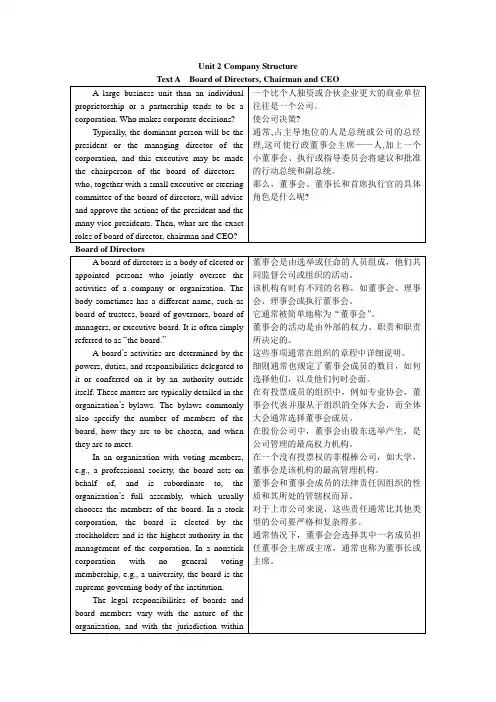
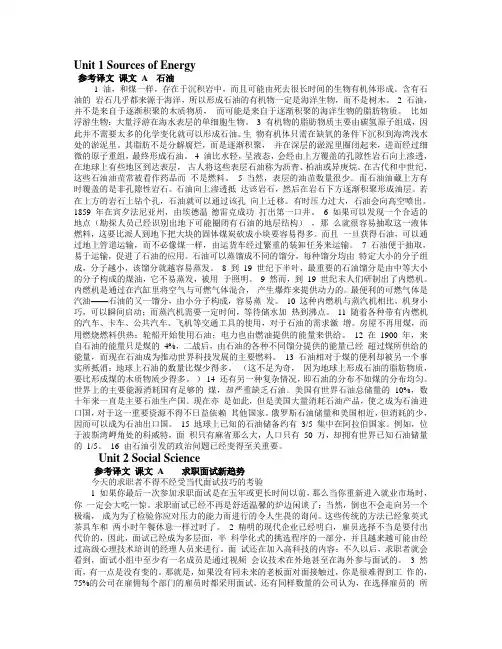
Unit 1 Sources of Energy参考译文课文A 石油1 油,和煤一样,存在于沉积岩中,而且可能由死去很长时间的生物有机体形成。
含有石油的岩石几乎都来源于海洋,所以形成石油的有机物一定是海洋生物,而不是树木。
2 石油,并不是来自于逐渐积聚的木质物质,而可能是来自于逐渐积聚的海洋生物的脂肪物质。
比如浮游生物:大量浮游在海水表层的单细胞生物。
3 有机物的脂肪物质主要由碳氢原子组成,因此并不需要太多的化学变化就可以形成石油。
生物有机体只需在缺氧的条件下沉积到海湾浅水处的淤泥里。
其脂肪不是分解腐烂,而是逐渐积聚,并在深层的淤泥里圈闭起来,进而经过细微的原子重组,最终形成石油。
4 油比水轻,呈液态,会经由上方覆盖的孔隙性岩石向上渗透,在地球上有些地区到达表层,古人将这些表层石油称为沥青、柏油或异庚烷。
在古代和中世纪,这些石油油苗常被看作药品而不是燃料。
5 当然,表层的油苗数量很少。
而石油油藏上方有时覆盖的是非孔隙性岩石。
石油向上渗透抵达该岩石,然后在岩石下方逐渐积聚形成油层。
若在上方的岩石上钻个孔,石油就可以通过该孔向上迁移。
有时压力过大,石油会向高空喷出。
1859 年在宾夕法尼亚州,由埃德温·德雷克成功打出第一口井。
6 如果可以发现一个合适的地点(勘探人员已经识别出地下可能圈闭有石油的地层结构),那么就很容易抽取这一液体燃料,这要比派人到地下把大块的固体煤炭砍成小块要容易得多。
而且一旦获得石油,可以通过地上管道运输,而不必像煤一样,由运货车经过繁重的装卸任务来运输。
7 石油便于抽取,易于运输,促进了石油的应用。
石油可以蒸馏成不同的馏分,每种馏分均由特定大小的分子组成,分子越小,该馏分就越容易蒸发。
8 到19 世纪下半叶,最重要的石油馏分是由中等大小的分子构成的煤油,它不易蒸发,被用于照明。
9 然而,到19 世纪末人们研制出了内燃机。
内燃机是通过在汽缸里将空气与可燃气体混合,产生爆炸来提供动力的。

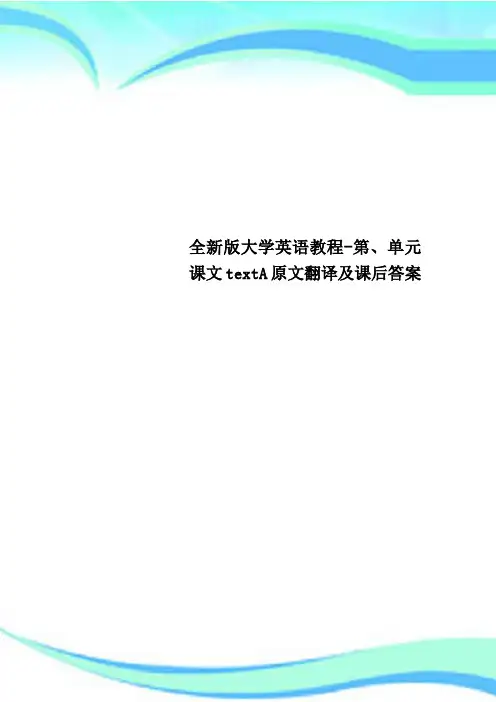
全新版大学英语教程-第、单元课文textA原文翻译及课后答案————————————————————————————————作者:————————————————————————————————日期:2unit 6 The Last LeafWhen Johnsy fell seriously ill, she seemed to lose the will to hang on to life. The doctor held out little hope for her. Her friends seemed helpless. Was there nothing to be done?约翰西病情严重,她似乎失去了活下去的意志。
医生对她不抱什么希望。
朋友们看来也爱莫能助。
难道真的就无可奈何了吗?The Last LeafO. Henry 1 At the top of a three-story brick building, Sue and Johnsy had their studio. "Johnsy" was familiar for Joanna. One was from Maine; the other from California. They had met at a cafe on Eighth Street and found their tastes in art, chicory salad and bishop sleeves so much in tune that the joint studio resulted.最后一片叶子欧·亨利在一幢三层砖楼的顶层,苏和约翰西辟了个画室。
“约翰西”是乔安娜的昵称。
她们一位来自缅因州,一位来自加利福尼亚。
两人相遇在第八大街的一个咖啡馆,发现各自在艺术品味、菊苣色拉,以及灯笼袖等方面趣味相投,于是就有了这个两人画室。
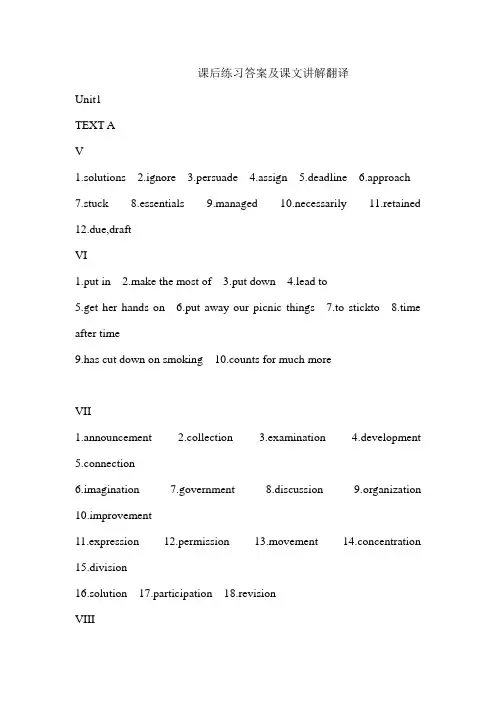
课后练习答案及课文讲解翻译Unit1TEXT AV1.solutions2.ignore3.persuade4.assign5.deadline6.approach7.stuck8.essentials9.managed 10.necessarily 11.retained 12.due,draftVI1.put in2.make the most of3.put down4.lead to5.get her hands on6.put away our picnic things7.to stickto8.time after time9.has cut down on smoking 10.counts for much moreVII1.announcement2.collection3.examination4.development5.connection6.imaginationernment8.discussionanization10.improvement11.expression 12.permission 13.movement 14.concentration15.division16.solution 17.participation 18.revisionVIII1. ..., thus cutting down on our costs.2. ...while eating/having/taking breakfast.3. ...so that he can memorise a couple of/a few new words every-day while cooking his meals.4. ..., thus greatly increasing his reading speed.5. ...while studying Chinese modern history at Beijing University.6. ...,thus being able to do/perform very well in their work.7. ...while doing his homework.8. ...so that you can become one, too.IXed to go2.got used to gettinged to study,has got used to workinged to sayed to write,got used to communicatingX1.Tom spent a lot of time preparing for the final exams2.A smart student spends a few minutes writing two or three sentences about the lesson'smain points3.Alex spent the rest of the afternoon playing tennis with Amanda4.Paul spent about 2 hours looking for a missing notebookXI1.went unnoticed2.go unpunished3.go uncorrected4.goes unnoticed unmentioned5.go unreportedXIIinterruption/waste concentrate organize/make the most ofirrelevant Taking retain/digest/absorb whether approachesdo/perform schedule/searchXIII1.A very curious boy, Tom is interested not only in whats but also in whys and hows.2.Happiness, according to Prof. Smith, is the ability to make the most of what you have.3.Y ou've better keep the book where your 15-year-old son can't get his hands on it.4.The story was so funny that Bill kept laughing all the time while reading it5.High-achieving students do not necessarily put in more time on theirstudies than their lower-scoring classmates.6.How did you manage to persuade these students to take the speed-reading course?7.Working hard is important, but knowing how to make the most of one’s abilities counts for much more.8.She asked her students to think for themselves rather than telling them what to think.TEXT BT T F F F T T TI1.opposite2.preference3.located4.feasible5.perspective6.has shifted7.concern8.attractive 9.survive 10.transfer 11.prospect 12.particularly 13.treasure 14.despiteII1.on the other hand2.keep up3.as for4.for good5.turned oute of age7.what if8.welled upunit2TEXT AIII1.response2.bounced3.Conversation4.previous5.encouragement6.parallelIV1.entirely2.objection3.challenged4.original5.responsible6.relative7.halfway8.startled9.simply 10.back and forth11.joined in 12.just as 13.knocked down 14.came to a halt15.Even if16.fell apartV1.unconsciously2.response3.previous4.suitable5.even though6.disagree7.topic8.calling on9.switched 10.and so on 11.in line12.take turnsVIabsence confidence convenience evidence independenceintelligence patience presence silence viloencedistance significance excellence1.Excellence2.independence3.intelligence4.significance5.patience6.silence7.violence8.diferences9.distance 10.confidenceVII1.disappeared2.disorder3.dishonest4.disobey5.disagree6.disadvantages7.discomfort8.dislike9.disbelief 10.dissatisfiedVIII(A)1.Whoever is most qualified2.Whoever has money3.Whoever holds it4.whoever is not with him5.whoever would take the job6.Whoever fears to face his own past(B)1.Whatever they have2.whatever decisions he makes3.Whenever the weather¡¯s bad4.wherever he goes5.Whichever direction you turn to6.however hard she triedIX1.No wonder it's freezing cold today2.No wonder there is no picture on the screen3.No wonder many career women are not married4.No wonder they asked so many questions5.No wonder it has become a best-seller of this spring6.No wonder US students are anxious about mathX1.you will have more free time2.he might be more patient3.I understand why so many older people like it4.he can rest for a few daysXI1.to how2.conversation3.forth4.what5.gradually6.for7.in8.however9.next 10.switch 11.similar12.still 13.differences 14.stylesXII1.Referring to the differences between American English and British English, he said, "The United States and Britain are, after all, two different countries. "2.Prof. Smith encourages his students to think for themselves. "I am just as happy, " he often says, "even if you challenge me or completely disagree with me. "3.We called on him to take part in our conversation about pop music, but as soon as he joined in, he introduced a new topic and referred to theNBA finals of the previous week.4.The driver is responsible for this accident. His car knocked down a tree and a man on his bike.5.Since our production of radios came to a halt, we have switched to the production of mobile phones.6.Our original plan was to see such famous sights as the Great Wall, the Palace Museum and the Summer Palace in Beijing.7.It's no simple/easy matter to learn a foreign language well. Even though I have learned English for a few years, I still can't express myself effectively in the language.8.I don't want you simply to agree or disagree with me. I need someone who can give me good advice, ideas, and so on.TEXT BI1.academic2.intelligence3.reflects4. Social5.predicted6.context7.advantage 8.attitude 9.traits munication 11.distinguish12.represented13.influenced 14.matureII1.getting acrosse out3.Because of4.in short5.as a result6.as well7.in some cases8.sent outunit3TEXT AIV1.draw2.bear3.worn out4.got tired of5.racial6.paid,attention to7.mature 8.broke into 9.performed 10.conquer 11.aspects 12.As far asV1.Brought up2.broke into running3.amzaed4.All could do was5.resemble6.with ease7.conquered8.wear out/are worn out9.turned out 10.has grown into 11.tragedy 12.promptilyVI1.personal2.traditional3.humorous4.logical5.courageous6.poisonouscational8.victoriousVII1.darkness2.carelessness3.nervousness4.prepareness5.illness6.eagernessVIII1.Ggo to playing2.went on readin3.went on to explain4.went go to teach5.went on playing6.went on to tellIX1.Susan said that she would get married only after she had made a name for herself in Hollywood.2He left the library only after he got his hands on the books he needed.3.Scientists realized that the brain controlled our thinking only after the 18th century.4.He goes to bed only after he writes up his diary every evening.5.He learned about the birth of his son only after he returned from a business trip.6.She broke into tears only after all the guests left.X1.work as fast as a skilled worker2.couldn't perform as well as his parens had expected3.he promised that he would go and see his grandparents as often as he could4.than after finishing his studies abroad he would come back as soon as pollibleXI1.with2.met3.Although4.blind5.childhood6.amzaed7.neighbors8.fight9.records 10.talent 11.accident 12.only 13. about 14.along15.attitudeXII1.As far as I know, all they have to do is come and see the child they want to bring up and fill up a form.2.As he learned more and more about the world, he finally got tired of going after fame and wealth.3.The little girl¡¯s songs brought sunshine to the old man and helped him bear the hardships of life.4.People came one after another to congratulate them on the successful building of another big bridge over the Huangpu River.5.All the people present were amazed that the 10-year-old boy was playing the violin so skillfully.6.After the car accident, Stevie reevaluated his goals in life and decided to pay more attention to the world outside.7.Even in her wildest dreams, Mother could never have imagined that her son would become a world-famous pianist.8.The students broke into loud cheers when they heard that their teacher had fought back from the shadow of death.TEXT BI1.potential2.suggestions3.realistic4.embarrassed5.impression6.negative7.presently8.reacted9.improvement 10.target 11.inferior 12.conceptII1.has built up2.dwell on3.be doing justice to myself4.form the start5.are based on6.set aside7.wiped out8.improve on9.do...harm 10.is working onunit4TEXT AIV1.endure2.accumulated3.some what4.propertyrmed6.wrinkled7.collapsing8.mourning 9.contributed 10.possesses 11.recovered 12.trembled13.fulfill14.drove 15.stagger 16.utteredV1.beacuse of2.be blessed with3.as well as4.spoke of5.a good deal of6.at most7.stand on its feet8.be ashamed of9.as soon 10.as leaning onVI1.a bearded young man2.three colored pictures3.a flowered lawn4.a gifted pianist5.an old lady with a wrinkled face6.a home for the aged7.a cultured college student 8.an experienced driver9.a skilled engineer 10.a spirited discussionVII1.shameless2.cheerful3.endless4.windless5.fearless6.countless7.meaningful8.colorful9.delightful 10.thoughtfulVIIInoIX1.Nor did he give me any explanation.2.Nor did he feel ashamed for that.3.Nor do I think it necessary to do so.4.Nor will he invite his relatives and friends.5.Nor did we know his phone number.6.Nor did she enter the home for the aged.X1.Extremely hot as it is, the workers are still working on the construction site.2.Big and strong as he is, he is afraid of hard work.3.Freezing cold as it was, Father went out hunting with his dog.4.Slow as it was, the boat offered its passengers very good service.5.Excited as we were at the news, we tried to keep ourselves calm.6.Brave as he was, Jimmy trembled at the sight of a snake.IX1.could have got2.could have asked3.could have been4.could have fulfilled5.could have got6.could have becomeXII1.wrinklesundry3.still4.after5.other6.did7.charged8.would9.burden 10.fell11.worried 12.bundle 13.how 14.property 15.letXIII1.Sickly and weak as Grandma is, she has taken on all the housework in the family.2.The recording company had never been so pleased with any singer. For them, Stevie Wonder was a real find.3.They had no running water where they lived. Nor did they have anyconveniences of life such as gas and electricity.4.Six years passed, then seven and eight, and nothing was heard of that French artist. It seemed certain that he had left the country for only God knows where.5.He was very ill that summer, but as soon as he felt better in the fall, he resumed his writing and finished his last novel in two months.6.Driven by a strong will, Alex finally fulfilled the task he had undertaken.7.With the help of the doctor and the nurses, the patient recovered quickly and in a few weeks was able t stand on his feet once more.8.It was really sad to watch the old man¡¯s wrinkled face, which spoke of all that he had borne/endured in his life.TEXT BI1.responsibility2.purchase3.portrays4.had vanished5.immense6.decent7.eventually8.motivation9.reputation 10.restore11.neighborhood12.sustain 13.upholds 14.creditII1.paved the way for2.is attributed to3.out of habit4.kept his word5.open the door to6.think twice7.think of as8.care about9.had been passed on 10.To this dayunit5TEXT AVpromise2.content3.Unfortunately4.individual5.gamble6.spun7.atractive 8.afterwards 9.tradition 10.unique 11.arose 12.energeticVI1.a little2.and so on3.as well4.give way to5.in the same way as6.had in mind7.most of the time8.have been on their feet9.went off 10.are named after 11.has no right to 12.sorted outVIIpromise with,over2.lying,in3.lie on4.content with5.call at6.called ond,after8.active in9.opinions about 10.opinion ofVIII1.uncertain2.unkown3.unable4.unfortunate5.incorrect6.impatient7.illegal8.irregular9.irrelevant 10.improperIXhiker winner loser painter teacher actormanager : a person who directs the affairs of a business, a sports team, etc.murderer :a person who murders someoneowner :a person who owns somethingplayer :a person who plays a game or a musical instrumentruler :a person who rulesconductor:a person who directs the playing of a group of musicians or a person employed to collect money and give out tickets on a bus or train director :a person who directs somethingsailor :a person who works on a shipvisitor :a person who visits a place or someoneinventor :a person who invents somethingX1.What a pity you won¡¯t be back before I leave!2.What a pity (it is) to waste the food!3.What a pity she isn¡¯t here!4.What a pity that we can die only once for our country!5.What a pity that some of the best acting on stage today can only be seen by so few6.people!What a pity you can¡¯t swim.XII1.That's where2.That's why3.that's where4.That's what5.That's how6.That's how7.that's when8.that's when9.that's what 10.That's whereXIII1.married2.advicepromise4.way5.remain6.arose8.tradition9.unique 10.question11.made 12.mind 13.suggested 14.how 15.someXIV1.They are Mary¡¯s sons Robert and William. One is named after her father, the other is named after her grandfather.2.He is not content with what he has already got. What a pity he never understands that happiness lies in contentment.3.She is very active in classroom activities. I am sure that she will make a good teacher.Y ou may have different opinions about it, but I hate the idea of urging people to drink,4.especially at a dinner party.We are prepared to give way a little to them on minor problems, but we will never promise with them on major questions ofRobert didn¡¯t usually get much exercise during the year, while his wife Mary was on her 6.feet most of the time. That was why it was impossible, or difficult at least, for them to choose a place they both liked for their holiday.David is a young writer with a high opinion of himself. He thinks that his writing style is 7.unique and refined. But unfortunately, that is not the case.All I want to say is that as individuals we enjoy many different rights but we have no right to do anything harmful to society.TEXT BI1.effective2.argument3.alert4.typical5.avoid6.patience7.hostile8.mention 9.significant plain 11.bothered 12.historical 13.tempted 14.selfishunit6TEXT AIV1.shocked2.admitted3.pursue4.prefer5.intelligent6.acquire8.cultivate 9.typical 10.pursuit 11.imported 12.bite pete14.constantly15.prestigious 16.extentV1.dedicated,to2.stood a chance3.held up as4.least of all5.conform topares,to7.done away with8.deprived of9.looked down upon10.adapt to11.instead of 12.keep upVI1.fatherhood2.wisdom3.betrayal4.withdrawal5.adulthood6.sportsmanship7.relationship 8.burial 9.bachelorhood 10.editorship 11.renewal12.citizenship13.scholarship 14.doctorship 15.boyhood 16.dismissal 17.boredom 18.membership19.partnership 20.denial 21.refusal 22.arrival 23.approval 24.survivalVII1.Not until the publication of the article did the U. S. leaders come torealize that something had gone wrong.2.Not until next week will the full text of the report be published.3.Not until the time of the final examinations did the student start to read his books.4.Not until we reconsider and change the system of values in our society will university professorships become rewarding positions.5.Not until he fled to Moscow with his family did his role as a Soviet spy become known.VIII1.If we are to promote higher education, we must try to make university professorship the most prestigious positions in the country.2.If we are to remain a world-class power, our universities must be able to train students to become first-class scholars and engineers.3.If you are to make your child a person of knowledge, you must encourage him to spend more time studying.4.If you are to apply for this scholarship, fill in the application form and return it now.5.If we are to further develop the economy of Shanghai, we have to make full use of the Y angtze River.IX1.stopped breathing2.stopped to think3.stop teasing4.stopped thinking,stopped trying5.stopped to listenX1.He is able to make the point as clear and convincing as his teacher.2.This is not so much a matter of putting more money into education asa matter of changing our anti-intellectual values.3.They think that social skills are as important as academic achievement to a student.4.The purpose of this article is not so much to answer as to discuss the question.5.Professional ballplayers are as respected and well paid as professors in this country.XI1.pursuit2.system3.intellectual4.hardworking5.popular6.donw7.same8.Professional9.hand10.institution11.negative 12.Rival pete 14.away 15.dedicated XII1.The problem lies in how people look at those students dedicated to the pursuit of knowledge.2.Our government has decided to put a lot more money into education than before.3.We have to train more first-class engineers to compete in the technology race with Japan.4.The intellectually curious and hard-working students should be praised and held up as examples to other students.5.Not until we do away with our anti-intellectualism do we stand a chance to remain a world-class power.6.We must adapt ourselves to the demands of our times, otherwise we¡¯ll fall behind the other industrialized nations of the world.7.The parents are proud of their son who is studying English while the other children are playing football.8.Do you really expect to improve your English without spending more time studying it?TEXT BI1.escapces2.specific3.frequent4.similar5.profit6.trends7.creative8.customer,customer9.consumers 10.diet11.manufacturer12.advertisementII1.pointed out2.is going out of fashion3.According to4.and the5.out of date6.broke downes along8.on top ofunit7TEXT AIV1.cretp2.presence3.whereas4.spoiled5.previously6.roaring7.merely8.ignorant9.confident 10.ventured 11.chased 12.liberalV1.stared ate of3.establish itself as4.threw,at5.came up to6.are for7.move in8.viewed as9.among other things 10.by chanceVI1.momentary2.lively3.attractive4.crderly5.selective6.deadly7.legendary 8.protective 9.constructive 10.costly 11.brotherly 12.honorary 13.progressive 14.sickly 15.customary 16.earthly 17.revolutionary 18.reactionary1.I thing so./ I think not2.I imagine so./ I imagine not3.I suppose so./ I suppose not4.I hope so./ I think notVIII1.but I did play football quite often when I was in college2.but sometimes I do go and visit my mother3.but they did do a lot of work for me too4.but we did learn a lot from him5.but he did go to the lecture and meet the professorIX1.previously2.ignorant3.nasty4.presence5.liberal6.for7.Among8.support9.threw 10.sent11.crept 12.roared 13.treated 14.as 15.afterwardsX1.Mr. Smith was viewed as a very liberal person who believed, among other things, that all men were equal under the law.2.It is not by chance that he won the prize; his success comes from his hard training.3.The teacher talked a lot with the white kids, trying to convince themthat all men are created equal, but nothing much came of it in the first few weeks.4.As I was a newcomer to that school, I felt lonely and friendless for a time.5.Day after day Wei Ming kept talking with Mrs Wilson, and his oral English became more and more fluent and natural.6.Whereas some of the kids were quite nasty during those first few weeks, a little white girl was especially friendly to me.7.I later came to know that the man who looked old and wrinkled was only about 45.8.After graduating from university, he soon established himself as a qualified and responsible teacher of English.TEXT BI1.personality2.dominatespetent4.substituting5.respond6.somehow7.determinedmunicate9.current 10.brief 11.glance 12.polish13.formal 14.senstitveII1.on their own2.for the most part3.kept his distance4.to no avail5.on occasion/now and then6.think over7.lit up 8.at ease 9.all right 10.now and then/on occasionUNIT8txet AIV1.one2.that/one3.one 5.ones 6.that 7.those V1.promises2.reliable3.project4.barely5.be abolished6.simultaneous7.endless8.primarily9.equivalents 10.application 11. incredible 12.purpose13.acceptance 14.stimulatingVI1.run into2.serves as3.well ahead of schedule4.arises ...frommunicate with6.brought about7.take advantage of 8.is sure tooVII1.the foreign spokesperson dismissed the reports about the president's health as rumor.2.the purpose of taking a job is not confined only to board-winning .3.i fell terribly sorry that during the holidays i didn't get around toreading any english books .4.the media's speculations about the film star's marriage turned out to be uninformed .5.scientists have spent years studying the way the brain retains information.6.strictly speaking,plays are meantb to be acted , not to be read in. VIII1.unhappy2. unnoticed3.unprepared4. unanswered5.unforeseen6.unfair7.unknown8.unclearunexpectedunbelievableIX1. unforgettable2.enjoyable3.questionable4.unimaginable5.unbearable6.regrettable7.changeable8.foreseeableX1.be introduced2.be tried3.be designed and programmed4.contribute5.be6.changeXI1.what she really hopes for2.what it means3.what it can offer them4.what the teacher says5.what you're doing and what's going on at school6.what this modern world would be likeXIIincredible/tremendous in essential crucial communicateinternet revolution territory about/on bringmake debates stimulate least metXIII1.not scientist knows exactly where the information highway will lead us in the decade ahead.2.it is crucial that developed countries and developing countries increase mutual understanding and mutual respect through more communication .3.from the very beginning, the mass media paid particular attention to this treatise on the personal computer.4.my nephew had thought that japanese , which is similar chinese in many ways,was easy to learn by heart, but it didn't turn out that way .5.you should have know better.the way a college professor teaches isnot confined only to telling his students the basic fact.he or she also stimulates discussions and debate.6.it was originally estimated that the project would take 5 years ,but because of the creativity of the workers as well as the engineers ,it was finished well ahead of schedule.7.the process of thinking about and writing his autobiography took the american writer more than three years ,during which he ran into many unimaginable difficulties .8.the doctors aren't sure what illness he is suffering from .that's why he has decided to retire ahead of schedule.Unit1 TextA优等生的奥秘埃德温·基斯特莎莉·瓦伦丁·基斯特现在是剑桥大学理科一年级学生的阿历克斯,曾在曼彻斯特的中学校队里踢足球,还导演过学校的戏剧演出——但他中学毕业时得了五个A 。
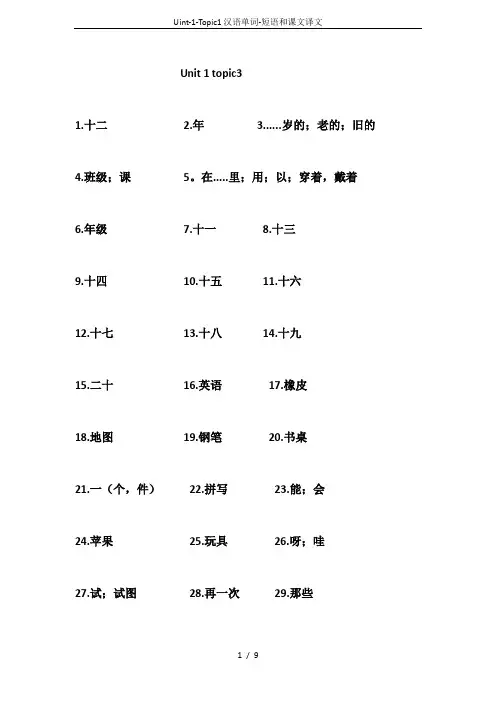
Unit 1 topic31.十二2.年3......岁的;老的;旧的4.班级;课5。
在.....里;用;以;穿着,戴着6.年级7.十一8.十三9.十四10.十五11.十六12.十七13.十八14.十九15.二十16.英语17.橡皮18.地图19.钢笔20.书桌21.一(个,件)22.拼写23.能;会24.苹果25.玩具26.呀;哇27.试;试图28.再一次29.那些30.书;本子31.这些32.让33.帮助34.尺子35.小汽车,轿车36.蛋37.柑橘38.公共汽车39.盒;箱40.现在41.学校42北京国际学校43.他的44.相同的45.但是,可是46.朋友47.初级的48.高的49.初中50.女孩51.我们52.学生53.讲,说;谈话Section A李明:你好,我是李明,你叫什么名字?简:我叫简。
李明:我十二岁。
你多大?简:我也十二岁。
李明:你在哪个班?简:我在七年级四班。
你也在四班吗?李明:不,我不是,我在五班。
Section B王俊峰:请问这个用英语怎么说?简:它是一块橡皮擦。
王俊峰:你怎样拼写它?简:E-R-A-S-E-R,橡皮擦。
王俊峰:谢谢。
简:不客气。
王俊峰:简,那个用英语怎么说?简:它是一幅地图。
王俊峰:请问,你会拼写它吗?简:会。
M-A-P,地图。
王俊峰:谢谢。
简:不客气。
Section C 嗨,王老师。
这些是什么?它们是书。
它们是英语书吗?是的,它们是。
那些是也英语书吗?不,它们是地图。
那些是什么?它们是尺子和铅笔。
让我来帮助你。
谢谢。
Section D简来自加拿大。
她十二岁。
现在在北京国际学校上学。
她在七年级四班。
她的电话号码是(010)92676929.黄华来自中国。
他的英文名字是汤姆。
他也十二岁。
他在七年级三班。
他的电话号码是(010)92525233.虽然黄华和简不在同一个班级,但他们是好朋友。
Uint 1,Topic1好的,爸爸早上女士,小姐欢迎女士中国下午感谢再见你们健康的美利坚和中国和联合国,美国安然无恙,好你好,喂在这里令人愉快的到,对,向;在...之前结识,遇见我也五个元音字母先生含有/ei/的字母遇见,看到,明白含有/e/的字母妈妈含有/i:/的字母这,这个电视我的光盘老师毫升怎样美国篮球协会做,助动词1早上好!我是康康。
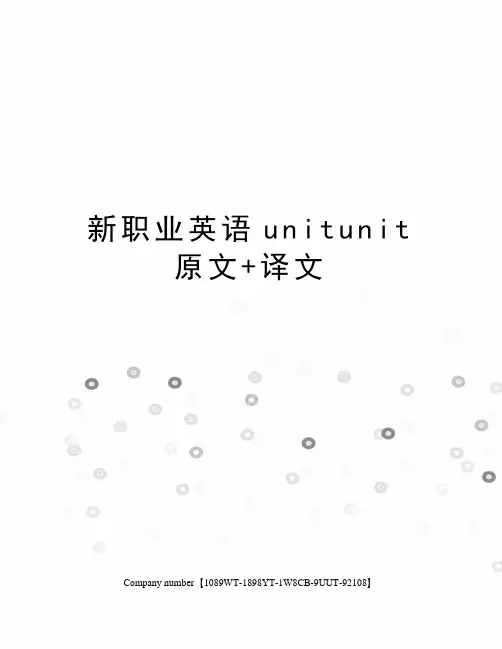
新职业英语u n i t u n i t原文+译文Company number【1089WT-1898YT-1W8CB-9UUT-92108】Unit 1Each day, many people are looking for trends in workplace clothing, so that they can “fit in” with the fashionable or well-dressed crowd. They believe that dressing in the latest fashion trends may give them the reputation of being fashionable and trendy. While it is more than possible to do this, you need to display caution.许多人每天都在捕捉职场时装的潮流,以便能与那些衣着时尚得体的人们步调一致。
他们认为按最新潮流穿衣打扮能为自己赢得时尚和时髦的好名声。
尽管这样做合情合理,你还是要小心谨慎。
What many people do not realize is that there are a number of pros and cons of relying on workplace fashion trends. One of those pros was mentioned above. When you wear a fashionable outfit to work, there is a good chance that you will receive a lot of compliments on your outfit. This is a nice feeling andit is one that makes many feel proud.许多人并没有意识到,追随职场时装潮流有利也有弊。
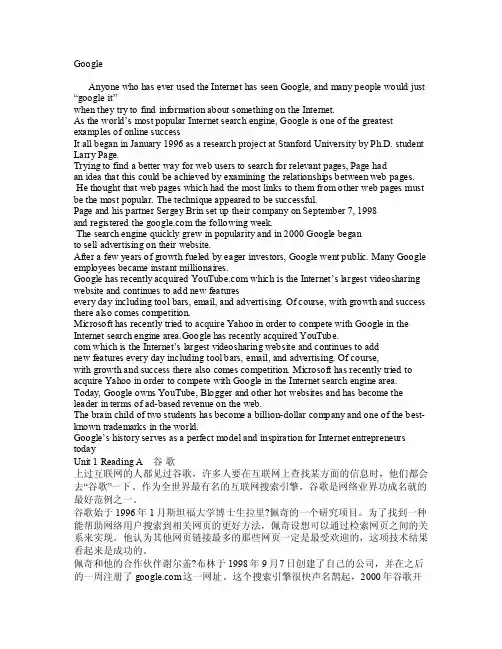
Google An yonewho h as ev er us ed th e Int ernet hasseenGoogl e, an d man y peo ple w ouldjust“goog le it”wh en th ey tr y tofindinfor matio n abo ut so methi ng on theInter net.As t he wo rld’s most popu lar I ntern et se archengin e, Go ogleis on e ofthe g reate stex ample s ofonlin e suc cessIt a ll be gan i n Jan uary1996as aresea rch p rojec t atStanf ord U niver sityby Ph.D. s tuden t Lar ry Pa ge. Tryin g tofinda bet ter w ay fo r web user s tosearc h for rele vantpages, Pag e hadan i dea t hat t his c ouldbe ac hieve d byexami ningthe r elati onshi ps be tween webpages.He thou ght t hat w eb pa ges w hichhad t he mo st li nks t o the m fro m oth er we b pag es mu st be themostpopul ar. T he te chniq ue ap peare d tobe su ccess ful.Pageand h is pa rtner Serg ey Br in se t uptheir comp any o n Sep tembe r 7,1998and r egist eredthe g ooglthe f ollow ing w eek.Thesearc h eng ine q uickl y gre w inpopul arity andin 2000 Go oglebeganto s ell a dvert ising on t heirwebsi te. After a fe w yea rs of grow th fu eledby ea ger i nvest ors,Googl e wen t pub lic.ManyGoogl e emp loyee s bec ame i nstan t mil liona ires.Goog le ha s rec ently acqu iredYouTu be.co m whi ch is theInter net’s larg est v ideos harin g web siteand c ontin ues t o add newfeatu res every dayinclu dingtoolbars, emai l, an d adv ertis ing.Of co urse, with grow th an d suc cessthere also come s com petit ion.Micr osoft hasrecen tly t riedto ac quire Yaho o inorder to c ompet e wit h Goo gle i n theInte rnetsearc h eng ine a rea.G oogle hasrecen tly a cquir ed Yo uTube.com whic h isthe I ntern et’slarge st vi deosh aring webs ite a nd co ntinu es to addnew f eatur es ev ery d ay in cludi ng to ol ba rs, e mail, andadver tisin g. Of cour se, withgrowt h and succ ess t herealsocomes comp etiti on. M icros oft h as re centl y tri ed to acqu ire Y ahooin or der t o com petewithGoogl e inthe I ntern et se archengin e are a.To day,Googl e own s You Tube, Blog ger a nd ot her h ot we bsite s and hasbecom e thelead er in term s ofad-ba sed r evenu e onthe w eb. The b rainchild of t wo st udent s has beco me abilli on-do llarcompa ny an d one of t he be st-kn own t radem arksin th e wor ld. Googl e’s h istor y ser ves a s a p erfec t mod el an d ins pirat ion f or In terne t ent repre neurstoda yUni t 1 R eadin g A 谷歌上过互联网的人都见过谷歌,许多人要在互联网上查找某方面的信息时,他们都会去“谷歌”一下。
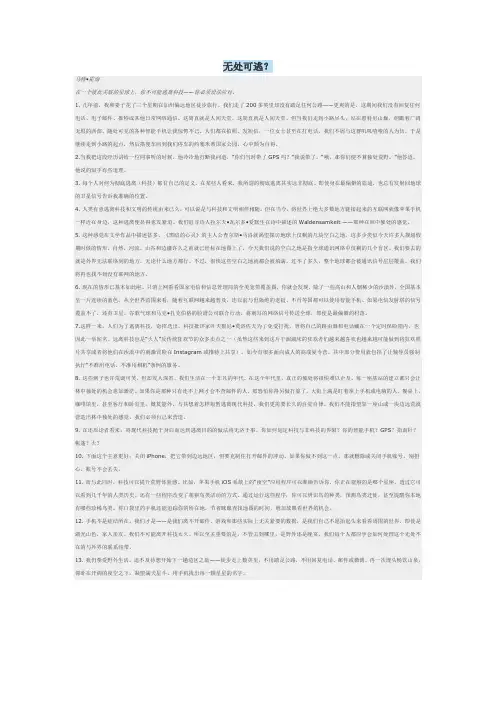
无处可逃?马特•霍南在一个彼此关联的星球上,你不可能逃离科技——你必须设法应对。
1. 几年前,我和妻子花了三个星期在加州偏远地区徒步旅行。
我们走了200多英里却没有踏足任何公路——更爽的是,这期间我们没有回复任何电话、电子邮件、推特或其他日常网络通信。
这简直就是人间天堂。
这简直就是人间天堂。
但当我们走到小路尽头,站在惠特尼山巅,俯瞰着广阔无垠的西部,随处可见的各种智能手机让我惊愕不已。
人们都在拍照、发短信,一位女士甚至在打电话。
我们不屑与这群叽叽喳喳的人为伍,于是继续走到小路的起点,然后搭便车回到我们停车的约塞米蒂国家公园,心中颇为自得。
2.当我把这段经历讲给一位同事听的时候,他冷冷地打断我问道,“你们当时带了GPS吗?”我说带了。
“哦,那你们便不算独处荒野。
”他答道。
他说的似乎有些道理。
3. 每个人对何为彻底逃离(科技)都有自己的定义。
在某些人看来,我所谓的彻底逃离其实远非彻底。
即使身在最偏僻的旅途,也总有发射回地球的卫星信号告诉我准确的位置。
4. 人类有意逃离科技和文明的传统由来已久,可以说是与科技和文明相伴相随。
但在当今,将世界上绝大多数地方链接起来的互联网就像苹果手机一样近在身边,这种逃离便显得愈发紧迫。
我们追寻诗人拉尔夫•瓦尔多•爱默生在诗中描述的Waldensamkeit ——那种在林中独处的感觉。
5. 这种感觉在文学作品中描述甚多。
《黑暗的心灵》的主人公查尔斯•马洛就渴望探访地球上仅剩的几块空白之地。
这多少类似今天许多人规划假期时候的情形。
自然,河流、山谷和边疆许久之前就已经标在地图上了,今天我们说的空白之地是指全球通讯网络中仅剩的几个盲区。
我们要去的就是外界无法联络到的地方,无论什么地方都行。
不过,很快这些空白之地就都会被填满。
过不了多久,整个地球都会被通讯信号层层覆盖,我们将再也找不到没有联网的地方。
6. 现在的情形已基本如此啦。
只消上网看看国家电信和信息管理局的全美宽带覆盖图,你就会发现,除了一些高山和人烟稀少的沙漠外,全国基本呈一片连续的蓝色。
![新职业英语1课文A翻译Unit1[五篇]](https://uimg.taocdn.com/0c5ba3b5dbef5ef7ba0d4a7302768e9951e76e9e.webp)
新职业英语1课文A翻译Unit1[五篇]第一篇:新职业英语1课文A翻译 Unit 1Unit 1 Reading A谷歌上过互联网的人都见过谷歌,许多人要在互联网上查找某方面的信息时,他们都会去“谷歌”一下。
作为全世界最有名的互联网搜索引擎,谷歌是网络业界功成名就的最好范例之一。
谷歌始于1996年1月斯坦福大学博士生拉里•佩奇的一个研究项目。
为了找到一种能帮助网络用户搜索到相关网页的更好方法,佩奇设想可以通过检索网页之间的关系来实现。
他认为其他网页链接最多的那些网页一定是最受欢迎的,这项技术结果看起来是成功的。
佩奇和他的合作伙伴谢尔盖•布林于1998年9月7日创建了自己的公司,并在之后的一周注册了这一网址。
这个搜索引擎很快声名鹊起,2000年谷歌开始在自己的网站出售广告。
在投资者的热情资助下,经过几年的发展,谷歌上市了,谷歌的很多雇员一夜之间成了百万富翁。
谷歌最近收购了互联网最大的视频共享网站,而且每天都在不断增加一些新功能,如工具栏、邮件和广告。
当然,成长与成功也带来了竞争。
微软最近就试图收购雅虎以便能在互联网搜索引擎领域与谷歌抗衡。
随着公司的壮大与知名度的提高,谷歌在美国公司就业吸引力的排名也上升到第一。
他们尝试打破传统的办公室设计,努力把办公室变成员工感觉舒适、并能充分发挥自己才华的地方。
现在,谷歌已拥有YouTube、Blogger和其他一些热门网站,并且成为网络广告收入方面的领头羊。
当初两个学生的一个小点子已发展成为一家拥有十亿美元资产的大公司,谷歌也成为全球最著名的商标之一。
谷歌的发展史为当今的网络企业家树立了一个完美的典范,也提供了灵感。
第二篇:新职业英语1课文A翻译 Unit 2Unit 2 Reading A秘书秘书可能会有很多其他不同的头衔,例如行政助理、文员或私人助理。
尽管所有这些头衔都以行政工作为主旨,但它们却反映了不同种类的秘书工作。
秘书岗位十分古老,例如,古希腊和罗马的商人和政客们就曾雇用私人秘书和文员来管理他们的事务。
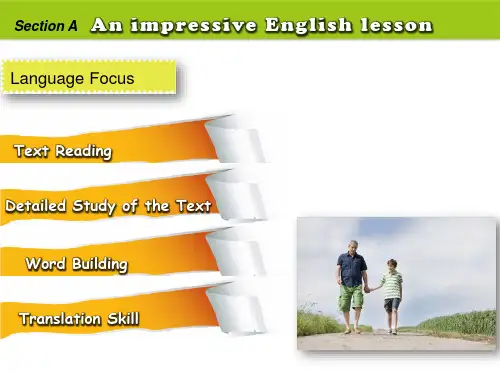
行业英语TextA课后翻译练习第一篇:行业英语TextA课后翻译练习U1各种市场供给形成顾客价值和满意度,顾客据此来判断是否购买。
满意的顾客会再次购买,并告诉别人他们的好经验。
不满意的顾客转投竞争对手,向他人贬低该产品。
顾客价值和顾客满意度是开发和管理顾客关系的关键组成部分。
U2 连锁商店一般由10家或10家以上的零售商店组成,执行标准化管理,采用统一的商品采购和配送制度,统一的经营管理标准,采购和销售分开。
所有的商品都通过总部采购;根据合理化库存流程、质量和新鲜度,某些商品可以直接供给和配送零售店。
其他的商品都是通过总部统一配送。
连锁商店由总部、零售店和物流配送中心构成。
U31.国际贸易是跨域国家界限及领土的商品与服务间的交换。
2.国际贸易是也是经济学的一个分支,和国际金融一起构成国际经济学这个更大学科分支。
日益增长的国际贸易是全球化的基础。
3.一个国家可以不进口某项生产要素,而通过进口能密集使用该生产要素的商品体现该生产要素。
4.经济强国通常大力支持自由贸易,尽管他们会对具有战略重要性的产业实行选择性保护主义。
5.贸易壁垒是一个描述任何限制国际贸易的政府政策或法规的通用术语。
U4 安达信咨询公司(现为埃森哲)首次把第四方物流提供商的概念定义为集成商。
它把自己组织和其他组织的资源、能力和技术整合起来,进行设计、建构和运行综合供应链解决方案。
第三方物流服务提供商把功能作为目标,而第四方物流把整个过程的管理作为目标。
有些人把第四方物流形容成一个总承包商。
由他来管理其他的第三方物流,卡车司机,货运代理,海关代理和其他方面,尤其是负责为顾客提供一个完整的服务过程。
U5 电子商务有8个基本的特征。
前3个特征涉及到电子商务环境的全球性。
普遍性意味着商业交易或活动可以在任何时候、在世界上的任何地方进行。
全球影响力是指一个企业能获得的潜在消费者的数量;这意味着高水平的全球互联网连接。
通用标准是指世界共享的标准,这意味着电子商务是在拥有协议方法和系统的标准平台上运行的。
Pre-reading Questions阅读前问题1. Do you usually challenge the idea an author represents?一。
你通常会质疑作者所代表的观点吗?What do you think is active reading你认为什么是主动阅读2. What suggestions do you expect the author will give on reading critically?2。
你希望作者对批判性阅读有什么建议?Critical Reading批判性阅读Critical reading applies to non-fiction writing in which the author puts forth a position or seeks to make a statement.批判性阅读适用于作者提出立场或试图发表声明的非小说写作。
Critical reading is active reading.批判性阅读是主动阅读。
It involves more than just inderstanding what an author is saying.它涉及的不仅仅是理解一个作者在说什么。
Critical reading involves questioning and evaluating what the author is saying, and forming your own opinions about what the author is saying.批判性阅读包括质疑和评价作者所说的话,并形成自己对作者所说的话的看法。
Hereare the things you should do to be a critical reader作为一个批判性的读者,你应该做以下几件事Consider the context of what is written.考虑一下所写内容的上下文。
英语(二)自学教程Unit1-TextA课文翻译详细解析Pre-reading Questions阅读前问题1. Do you usually challenge the idea an author represents?一。
你通常会质疑作者所代表的观点吗?What do you think is active reading你认为什么是主动阅读2. What suggestions do you expect the author will give on reading critically?2。
你希望作者对批判性阅读有什么建议?Critical Reading批判性阅读Critical reading applies to non-fiction writing in which the author puts forth a position or seeks to make a statement.批判性阅读适用于作者提出立场或试图发表声明的非小说写作。
Critical reading is active reading.批判性阅读是主动阅读。
It involves more than just inderstanding what an author is saying.它涉及的不仅仅是理解一个作者在说什么。
Critical reading involves questioning and evaluating what the author is saying, and forming your own opinions about what the author is saying.批判性阅读包括质疑和评价作者所说的话,并形成自己对作者所说的话的看法。
Hereare the things you should do to be a critical reader作为一个批判性的读者,你应该做以下几件事Consider the context of what is written.考虑一下所写内容的上下文。
Unit5 The Company Man1.He worked himself to death, finally and precisely, at 3:00 . Sunday morning.2.The obituary didn’t say that, of course. It said that he died of a coronarythrombosis —I think that was it —but everyone among his friends and acquaintances knew it instantly. He was a perfect Type A2, a workaholic, a classic, they said to each other and shook their heads —and thought for five or ten minutes about the way they lived.3.This man who worked himself to death finally and precisely at 3:00 . Sundaymorning — on his day off — was fifty-one years old and a vice-president. He was, however, one of six vice-presidents, and one of three who might conceivably — if the president died or retired soon enough — have moved to the top spot. Phil knew that.4.He worked six days a week, five of them until eight or nine at night, during a timewhen his own company had begun the four-day week for everyone but the executives. He worked like the Important People3. He had no outside “extracurricular interests,” unless, of course, you think about a monthly golf game that way. To Phil, it was work. He always ate egg salad sandwiches at his desk. He was, of course, overweight, by 20 or 25 pounds. He thought it was okay, though, because he didn’t smoke.5.On Saturdays, Phil wore a sports jacket to the office instead of a suit, because it wasthe weekend.6.He had a lot of people working for him, maybe sixty, and most of them liked himmost of the time. Three of them will be seriously considered for his job. The o bituary didn’t mention that.7.But it did list his “survivors” quite accurately. He is survived by his wife, Helen,forty-eight years old, a good woman of no particular marketable skills, who worked in an office before marrying and mothering. She had, according to her daughter, given up trying to compete with his work years ago, when the children were small.A company friend said, “I know how much you will miss him.” And she answered,“I already have.”8.“Missing him all these years,” she must have given up par t of herself which hadcared too much for the man. She would be “well taken care of.”9.His “dearly beloved” eldest of the “dearly beloved” children is a hard-workingexecutive in a manufacturing firm down South. In the day and a half before the funeral, he went around the neighborhood researching his father, asking the neighbors what he was like. They were embarrassed.10.His second child is a girl, who is twenty-four and newly married. She lives near hermother and they are close, but whenever she was alone with her father, in a car driving somewhere, they had nothing to say to each other.11.The youngest is twenty, a boy, a high-school graduate who has spent the lastcouple of years, like a lot of his friends, doing enough odd jobs to stay in grass and food4. He was the one who tried to grab at his father, and tried to mean enough to him to keep the man at home. He was his father’s favorite. Over the last two years, Phil stayed up nights worrying about the boy.12.The boy once said, “My father and I only board here5.”13.At the funeral, the sixty-year-old company president told the forty-eight-year-oldwidow that the fifty-one-year-old deceased had meant much to the company and would be missed and would be hard to replace. The widow didn’t look him in the eye. She was afraid he would read her bitterness and, after all, she would need him to straighten out the finances — the stock options6 and all that.14.Phil was overweight and nervous and worked too hard. If he wasn’t at the officehe was worried about it. Phil was a Type A, a heart-attack natural. You could have picked him out in a minute from a lineup.15.So when he finally worked himself to death, at precisely 3:00 . Sunday morning, noone was really surprised.16.By 5:00 . the afternoon of the funeral, the company president had begun, discreetlyof course, with care and taste, to make inquiries about his replacement. One of three men. He asked around: “Who’s been working the hardest”公司人1.他终于在礼拜天凌晨三点整因过度劳累而离开人世。